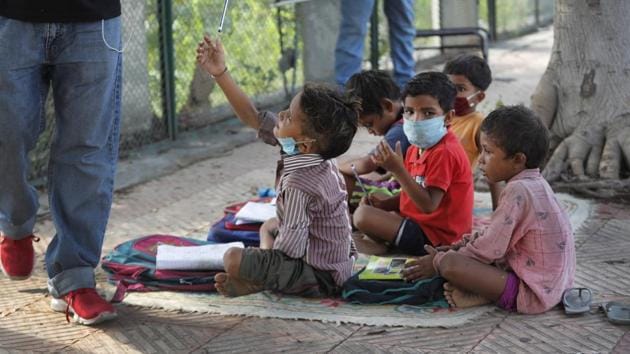Stopping a Covid-19 generation of stunted children essential
With 50 million children remaining stunted (low height for age), India still accounts for a third of the global burden of childhood stunting.
The take-home rations programme under the Integrated Child Development Scheme (ICDS) was halted for the first three weeks after the lockdown, following which the government and partners swung into action to ensure they reached beneficiaries, which are upwards of 70 million children and 17-19 million women.

“Many states started giving take-home rations on a fixed day, some like Telangana used volunteers to distribute to homes. But even with the best efforts, the reach has not returned to pre-Covid levels. If take-home rations over the past seven months reached 50% of beneficiaries of pre-Covid days, we should accept it as success,” said Dr Rajan Sankar, director, The India Nutrition Initiative, Tata Trusts.
Under the take-home ration programme, energy-dense micronutrient fortified extruded blended food (Balbhog) is given to children between the ages of seven months and three years (seven packets to normal weight, 10 for severe underweight) to meet their nutritional requirements. Initiatives such as these have helped bring down stunting (low height for age) from 48% in 2005-06 to 34.7% in 2018, and a close to 10% decline in underweight children, with 33.4 per cent children recorded as underweight in 2018.But with 50 million children remaining stunted (low height for age), India still accounts for a third of the global burden of childhood stunting.
Click here for complete coronavirus coverage
“The first two months after lockdown were a nightmare, and take-home rations stopped completely. Raw materials were not available, markets were closed, transport stopped, staff and self-help groups were afraid of infection and did not know the safety protocols or what to make. There were lots of practical problems, which got streamlined by the middle of May. If anything, it proved the need for decentralisation and standardisation,” Sachin Jain, Right To Food campaign activist in Bhopal, Madhya Pradesh.
Since March, millions of India’s poor have been depending on rice, wheat and dal (lentils) given under the public distribution system, which does not meet the nutritional needs of pregnant women and children under three years. Experts fear it will lead to a surge in underweight, stunting and wasting among children, low birth weight babies, anaemia, and low body weight adolescents and adults.
“India took two decades to bring down low birth-weight in children. This will be the first thing that will go up. Underweight and stunted children will grow up to be small adults and they will have small children. So, we will have a Covid generation of underweight adults who will produce one more generation of underweight children. We have to really work to prevent this, and hopefully plasticity may help overcome the nutritional deficit,” said Sankar. Plasticity is human adaptability to adapt to changing environment.
Poor nutrition in the first 1,000 days of life causes irreversible damage to the child’s physical and mental development. Undernourished children are physically smaller than average and have weaker immunities, raising their chances of getting infections, including life-threatening ones such as pneumonia and diarrhoea. Each episode of diarrhoea leads to a child losing vital nutrients from the body, with repeated infections leading to stunting and wasting.
The Covid-19 setback will make it tougher to achieve India’s national nutrition mission vision 2022 gals to lower undernutrition by 3% each year and decrease anaemia in children and women by a third.
“It will take anything from between three and six months (to reach pre-lockdown beneficiaries), if we make a sincere attempt to start doing it for all services to ensure optimally nutritious food reaches children, and pregnant and lactating women,” said Shankar.
India’s ICDS programme is the world’s biggest food supplementation programme that targets children in the first 1,000 days of life, pregnant women and women in the first six months after delivery to lower food insecurity and protein-energy malnutrition. Since 1975, hunger has reduced dramatically in India, which calls for a need to focus on nutritionally-optimal supplementation to also meet micronutrient deficiencies so that it supplements a poor diet being eaten at home, and does not simply replace it with another poor diet.
An obvious way to supercharge supplementation is by fortification, which can be done at the smallest self-help group level with standardization and training. “Supplements with empty calories should not be used, we should have a balanced energy-protein supplement with the right nutrients. No new research is required, we know what is needed, it just needs to be changed. We have a programme, we have the budget for it, we just need to correct it to make it nutritionally optimal. The moment we do it and show it, it will work,” said Sankar.
Using the same food for mothers and children doesn’t work as children between six months and two years require highly nutritionally dense food because they eat less than adults. Since the nutritional requirement per kg of bodyweight is much higher for children, giving them adult food children doesn’t provide them the required calories or vitamins and minerals to develop. ICDS ration must be especially prepared for children in much smaller quantities for optimal growth and development.
Get Current Updates on India News, Lok Sabha Election 2024 Voting live, Assembly Election 2024 Voting Live, Elections 2024, Election 2024 Date along with Latest News and Top Headlines from India and around the world.




